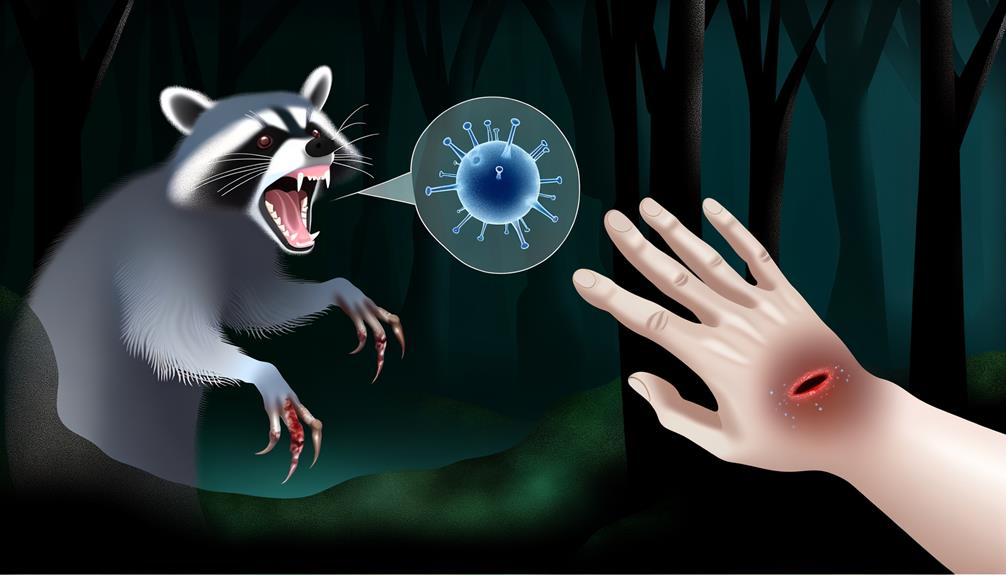How Do You Get Rabies from a Raccoon?
Rabies can be contracted from a raccoon through bites or scratches that introduce the virus-laden saliva into the bloodstream. The rabies virus, a member of the Lyssavirus genus, travels via peripheral nerves to the brain, causing severe encephalitis.
Once symptoms such as fever, headache, and neurological alterations appear, the disease is almost invariably fatal. Raccoons are significant rabies vectors, particularly in the eastern United States, making encounters with them a notable risk factor.
Prompt medical attention, thorough wound cleaning, and post-exposure prophylaxis are vital for preventing fatality. Immediate and appropriate action is crucial to manage exposure risks effectively.

Key Takeaways
- Rabies is transmitted from raccoons to humans through bites or scratches contaminated with infected saliva.
- The rabies virus enters the bloodstream via saliva exposure from raccoon bites or scratches.
- High saliva virus concentration in raccoons facilitates efficient rabies transmission.
- Symptoms of rabies can appear from days to months after exposure to infected raccoon saliva.
- Immediate medical attention and wound cleaning are crucial after potential rabies exposure from a raccoon.
What Is Rabies?
Rabies is a viral zoonotic disease that affects the central nervous system of mammals, including humans, leading to encephalitis and, if untreated, almost always resulting in death. The causative agent is the rabies virus, a member of the Lyssavirus genus.
Transmission typically occurs through the saliva of infected animals via bites or scratches. Once the virus enters the host, it travels along peripheral nerves to the brain, causing severe inflammation. Early symptoms may include fever, headache, and general weakness, progressing to neurological manifestations such as agitation, hallucinations, and hydrophobia.
Immediate administration of post-exposure prophylaxis (PEP) is vital for preventing the onset of symptoms and subsequent fatality. Public health education and vaccination of domestic animals are essential measures for rabies prevention.
Rabies Virus in Raccoons
Among the various wildlife species susceptible to rabies, raccoons are significant vectors due to their high population densities and frequent interactions with both domestic animals and humans. The rabies virus (genus Lyssavirus) infects the central nervous system, leading to acute encephalitis and eventual death if untreated.
Raccoons serve as a primary reservoir for rabies, particularly in the eastern United States. The virus is transmitted through saliva, often via bites, and can survive in raccoons for extended periods before symptoms appear. This asymptomatic phase complicates early detection and containment efforts.
Monitoring raccoon populations and implementing vaccination programs are essential strategies for minimizing the risk of rabies transmission to humans and other animals.
Bite Transmission
Transmission of the rabies virus from raccoons to humans or other animals primarily occurs through bites, where the infected saliva enters the victim's bloodstream. This form of transmission is highly efficient due to the direct inoculation of the virus into the tissue, facilitating rapid viral replication and spread. Immediate medical attention is essential following a raccoon bite to initiate post-exposure prophylaxis (PEP) and prevent the onset of rabies, a universally fatal disease if not treated promptly.
| Aspect | Description | Action Required |
|---|---|---|
| Transmission Method | Bite from infected raccoon | Seek immediate medical attention |
| Virus Entry Point | Bloodstream via saliva | Clean wound thoroughly |
| Symptoms Onset | Days to months after exposure | Monitor for early symptoms |
| Preventative Measure | Post-exposure prophylaxis (PEP) | Administer PEP promptly |
This table summarizes key aspects relevant to bite transmission of rabies from raccoons.
Scratch Transmission
Although less common than bites, scratches from an infected raccoon can also transmit the rabies virus if the animal's saliva contaminates the wound. The rabies virus resides in the saliva and nervous tissue of infected animals.
When a raccoon scratches a human or another animal, the virus can be introduced into the body through the broken skin if it is present on the raccoon's claws. This mode of transmission underscores the importance of immediate wound cleansing and medical evaluation following any raccoon scratch.
Healthcare professionals should be consulted promptly to assess the risk and determine if post-exposure prophylaxis (PEP) is necessary. Early intervention is critical to prevent the onset of rabies, a disease that remains almost universally fatal once symptoms appear.
Saliva Exposure
Saliva exposure is a primary route of rabies transmission, occurring when the virus-laden saliva of an infected raccoon comes into direct contact with mucous membranes or open wounds. This method of transmission is highly efficient due to the high concentration of the rabies virus in the saliva of symptomatic animals.
To mitigate risks, it is essential to understand the following key points:
- Bites: The most common means of saliva exposure, where the raccoon's teeth break the skin, allowing saliva to enter the bloodstream.
- Scratches: Less common, but possible if the raccoon's claws carry saliva that contaminates an open wound.
- Indirect Contact: Rare cases where saliva contacts mucous membranes such as the eyes, nose, or mouth, even without a bite or scratch.
Understanding these points aids in effective prevention and prompt action.
Symptoms in Humans
The onset of rabies in humans is marked by initial symptoms such as fever, headache, and general malaise, which can evolve into more severe neurological manifestations. Early indicators may be nonspecific and resemble influenza, complicating prompt diagnosis.
As the virus progresses, patients may experience anxiety, confusion, agitation, and hallucinations. Hydrophobia, or fear of water, and aerophobia, fear of air drafts, are hallmark symptoms resulting from pharyngeal spasms. Paralysis and hyperactivity can also occur.
Without timely intervention, these symptoms typically culminate in coma and eventual death. Immediate medical attention following potential exposure is critical to prevent the onset of these severe manifestations, underscoring the importance of early detection and post-exposure prophylaxis.
Symptoms in Pets
While rabies symptoms in humans are severe and life-threatening, pets infected with the virus exhibit their own set of distinct clinical signs that necessitate immediate veterinary attention. Infected pets may show a range of behavioral and physical symptoms, varying in intensity and progression.
- Behavioral Changes:
- Pets may exhibit uncharacteristic aggression, anxiety, or confusion.
- Increased irritability and sudden mood swings are also common.
- Neurological Symptoms:
- The onset of paralysis, particularly in the hind limbs, and seizures may occur.
- Pets may also display uncoordinated movements and difficulty swallowing.
- Hydrophobia and Hypersalivation:
- Affected animals often develop a fear of water (hydrophobia) and excessive drooling (hypersalivation), indicative of muscle control issues in the throat and mouth.
Prompt recognition and response are critical in managing rabies in pets.
Immediate Actions
Upon suspecting a rabies infection in a pet, immediate isolation of the animal is crucial to prevent transmission to humans and other animals. Secure the pet in a confined area where it cannot interact with any other living beings. Use protective gear, such as gloves and long sleeves, to avoid direct contact.
Notify local animal control authorities immediately for guidance and potential quarantine procedures. Guarantee that all household members are informed and avoid handling the isolated pet. Disinfect any areas the pet has come into contact with using appropriate virucidal agents.
Document all observations, including the pet's behavioral changes and possible exposure sources, to assist veterinary professionals and public health officials in their assessment and response.
Medical Treatments
After ensuring the pet is isolated and authorities are notified, the next step involves seeking appropriate medical treatments to address potential rabies infection.
Immediate medical intervention is essential to mitigate the risks associated with rabies.
The following steps are typically involved:
- Wound Cleaning: Thoroughly clean the wound with soap and water to reduce the viral load.
- Post-Exposure Prophylaxis (PEP): Administer a series of rabies vaccinations and, if necessary, rabies immunoglobulin (RIG) to elicit an immune response.
- Medical Monitoring: Continuous monitoring for symptoms such as fever, discomfort, and neurological changes over a specified period.
These steps are critical in ensuring the best possible outcome and preventing the progression of rabies, a potentially fatal disease.
Prevention Tips
To minimize the risk of contracting rabies from raccoons, implementing strict prevention strategies is crucial. Adherence to these measures can greatly reduce the likelihood of exposure:
- Vaccinate pets: Make sure that all domestic animals, especially cats and dogs, are up-to-date with their rabies vaccinations.
- Secure trash: Use raccoon-proof containers to prevent raccoons from scavenging in your area.
- Avoid contact: Never attempt to feed, touch, or handle wild raccoons.
| Prevention Measure | Description |
|---|---|
| Vaccinate Pets | Regular rabies vaccinations for pets |
| Secure Trash | Use raccoon-proof containers to limit food sources |
| Avoid Contact | Do not interact with or feed wild raccoons |
Conclusion
To sum up, rabies transmission from raccoons occurs primarily through bites, scratches, or saliva exposure, necessitating immediate medical intervention and treatment.
Recognizing symptoms in pets and adhering to prompt actions can mitigate risks.
Preventative measures, such as vaccination and avoiding contact with wildlife, are paramount.
As the adage goes, 'An ounce of prevention is worth a pound of cure.'
Understanding these mechanisms is essential for safeguarding both human and animal health against this fatal virus.






